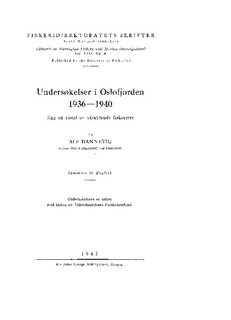| dc.description.abstract | In recent years the Oslo fjord has been made the subject of a more
intense study as regards the hydrographical and biological conditions.
The fjord is 55 naut. miles long, and is divided into several basins by
narrows and submerged barriers. (Fig. 6 and 7). The entrance to the
fjord from the Skagerack is comparatively open. In the outer part
fresh water from the rivers, the Drammenselv and the Glomma, affects
the salinity of the surface layers especially during the spring. The inner
part is affected by sewage water from Oslo.
Owing to the submerged bariers and the stability of the water
the intermediate and lower layers inside the Drøbak sound are often
stagnant and their content of oxygen is low (fig. 7). The seasonal temperature
variations are also small (fig. 8. Ramtongrunnen).
The salinity near the surface varies greatly according to the rainfall
and the direction of the wind. A southerly wind keeps the fresh water
inside the fjord, a northerly wind carries it out.
It is an integral part of the present investigations to ascertain
the amount of fish eggs and larvae in the fjord. The report gives the
results of this part of the work up to the spring of 1940, when operations
had to be discontinued owing to the war.
In 9 localities (see fig. 6) the hydrographical conditions were
examined and ascertained. As a rule 4 horizontal hauls of 10 mins.
duration at deptht of 0, 10, 20 and 30 m below the surface were carried
out with the egg net (1 m in diameter), and 2 hauls of 20 minutes
at 10 and 30 m with the young-fish net (2 m in diameter). These
operations were performed in the course of three cruises each spring.
In the summer and autumn three cruises were made for the purpose
of examining the hydrographical conditions,
The following results were ascertained. The quantaties of spawn
show that spawning must be intense in the outer fjord from the beginning
of March. In the inner fjord spawning is generally less intense until
April, when there is an abundance, especially of sprat spawn.
It would seem, however, that the eggs do not develop at a normal
rate in the inner fjord, the percentage of eggs with advanced embryos
being extremely low inside Drøbak, but normal outside. With regard
to the eggs of cod and haddock see fig. 25.
Table 15 on page 60 shows the total number of fish larvae &
young. The number accords with the occurrences of eggs at later stages,
being high in the outer and low in the inner fjord, except during the
month of May.
The poor results of the natural hatching of eggs in the inner fjord
during early spring are probably due to the effects of sewage water
from Oslo. In late spring the higher temperature and increased intensity
of light may have a natural purifying effect on the sea water.
As has been pointed out by Wiborg (1940), crustacean plankton also
develop very late in the inner fjord. This naturally provides poorer
nourishment for the early hatched larvae.
From table 16 it will be seen that in 1936 we caught less than
25 % of the amount of larvae taken in the subsequent years. In 1937
there was an abundance of sprat larvae, in 1938 of cod larvae, and in
1939 of herring and haddock larvae. No attempt has been made to
indicate the cause or causes of this variation, as we lack the material
for estimating the amount of spawners of the different species.
A special aspect which is dealt with is the effect of releasing
artificially hatched cod fry into the inner fjord. This was done only
in one year - 1938, but it is the intention to continue the experiment.
Not much can be said on the basis of the results of a single year,
owing to the great variation in the natural breeding. | en |
